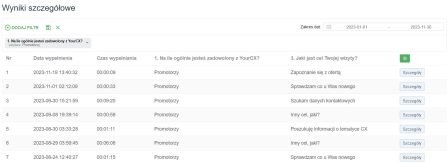Detailed Results
The Detailed Results section in the YourCX platform allows users to review each individual survey submission. In addition to the respondent’s answers, users have access to a wide range of contextual data such as basic metadata, on-site behavior paths, and customer-triggered events. This enables a thorough understanding of user interactions and experience.
Detailed Results View
Within the detailed results view, users can:
Apply filters – Narrow the dataset using specific criteria for focused analysis.
Adjust date range – Define the time period of survey completions for targeted reviews.
Customize the view – Add or remove columns to focus on the most relevant information.
By default, the table includes key data points such as:
Date and time of survey submission
Survey duration
Basic respondent answers
This view serves as a granular tool for exploring individual experiences and uncovering patterns that may not be visible in aggregate results.

Single Response Analysis
Full data for each submission is accessible only after opening the details of a specific entry. In this view, the user gains access to all available information, including:
Answers to all survey questions
Basic metadata, such as the URL, operating system, time of completion, technical details, and analytical data
User navigation path on the website
Customer events — actions previously defined as events within the platform
Depending on user permissions, an individual response can be deleted — for example, if its quality is questionable or if there's suspicion of dishonest behavior by the respondent.
Additionally, a task can be created directly from a single survey response within the platform’s task management system. This ensures that important submissions receive follow-up attention and are not overlooked.
Response Saving
Every survey response is saved — even if the user abandons the process before completion — as long as autosave is not disabled for the survey.
This functionality enables analysis of partial responses, helping to identify potential issues in survey structure or user behavior that may be causing drop-offs.